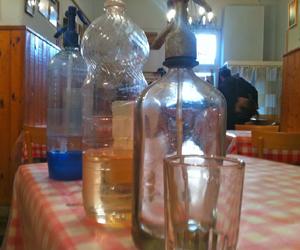Hungary’s national drink: seltzer water
Seltzer bottles are a fixture on the tables of Hungarian restaurants. (Photo by Nate Tabak.)
Bubbly water’s on the menu in just about every café and restaurant in Hungary.
The fizzy stuff caught on here back in the 1800s, but came into its own in the 1940s and 1950s when the local version of a wine spritzer, called a fröccs, became popular.
People in Hungary, which is famous for traditional delicacies like paprika and goulash, perfer to wash down flavoravle foods like that with water that is carbonated and fizzy.
At Kadar Restaurant in Budapest, you can be pretty sure of two things. You’ll leave with a full belly. And you’ll fill up numerous glasses of seltzer.
Each table has one, if not two, plastic seltzer dispensers – the kind with old-fashioned nozzles. The seltzer helps wash down the restaurant’s hearty Hungarian staples, like roasted goose leg.
Sandor Orban, who owns Kadar, said regulars don’t bother to ask. As soon as they sit down, they fill themselves a glass “szoda.” They drink so much of the stuff, Kadar goes though nearly 500 bottles a week. At about a quarter a glass, szoda isn’t a bad deal, either.
According to Orban, foreign visitors often aren’t sure what do with the dispensers, which are staples of Hungarian life.
“At first they’re a little surprised — they don’t understand” he said. “And then they try. You know, they play with it a little bit. They figure it out.”
But Orban covers the tables in plastic just in case they don’t.
The szoda at Kadar is hardly a novelty. Seltzer dispensers are everywhere in Hungary. At restaurants, bars, and in homes, it’s hard not to find some szoda. Orban traces it back to the early years of communist Hungary. He said the wine was so bad in the 1940s and 50s that seltzer was only way to make it drinkable.
But Seltzer actually goes back further in Hungary. In the 1800s, a priest and scientist named Anyos Jedlik pioneered a way to produce carbonated water on a commercial scale. To Hungarians, Jedlik is seltzer’s founding father.
Just outside Budapest, in Delegyhaza, the fizzy tradition is very much alive at the mom-and-pop owned Szoda Kiraly, or Soda King. The process is very simple. A hose sends carbon dioxide into a metal chamber, and there it mixes with tap water.
The Soda King himself is Gabor Mozsolics, a former flight attendant.
Last year, Mozsolics and his wife sold more than 100,000 liters out of their home. Refillable plastic dispensers are the bread and butter of their business, which people use while making fröccs.
Tamas Soros at Baldaszti’s Grand in Budapest calls his fröccs the hazmester, or house master fröccs.
“Every combination’s got another name, for example, kis fröccs, nagy fröccs, little fröccs, big fröccs,” Soros said.
There’re at least 16 kinds of fröccs, each corresponding to a precise mix of seltzer and wine.
“It’s a fresh, fresh drink. The Hungarian people really like it,” Soros said.
Tamas Fricz said he drinks fröccs every day in the summer.
“You can get more power from it,” Fricz said. “If you’re tired, it’s a very fresh drink.”
But Fricz, who’s 21, said plain seltzer is the drink of grandfathers. Hungarians his age don’t have much of a taste for it, though he’s not quite sure why.
But Mozsolics, the Soda King, said he’s not having trouble marketing his seltzer.
“It’s not about who’s a businessman or a bachelor. Everybody drinks it,” Mozsolics said.
And as a board member of the Hungarian Sodamakers’ Association, he knows a thing or two about the seltzer market. According to association figures, 66 percent of Hungarians drink seltzer.
The Soda King says that leaves plenty of room for the seltzer business to grow.
